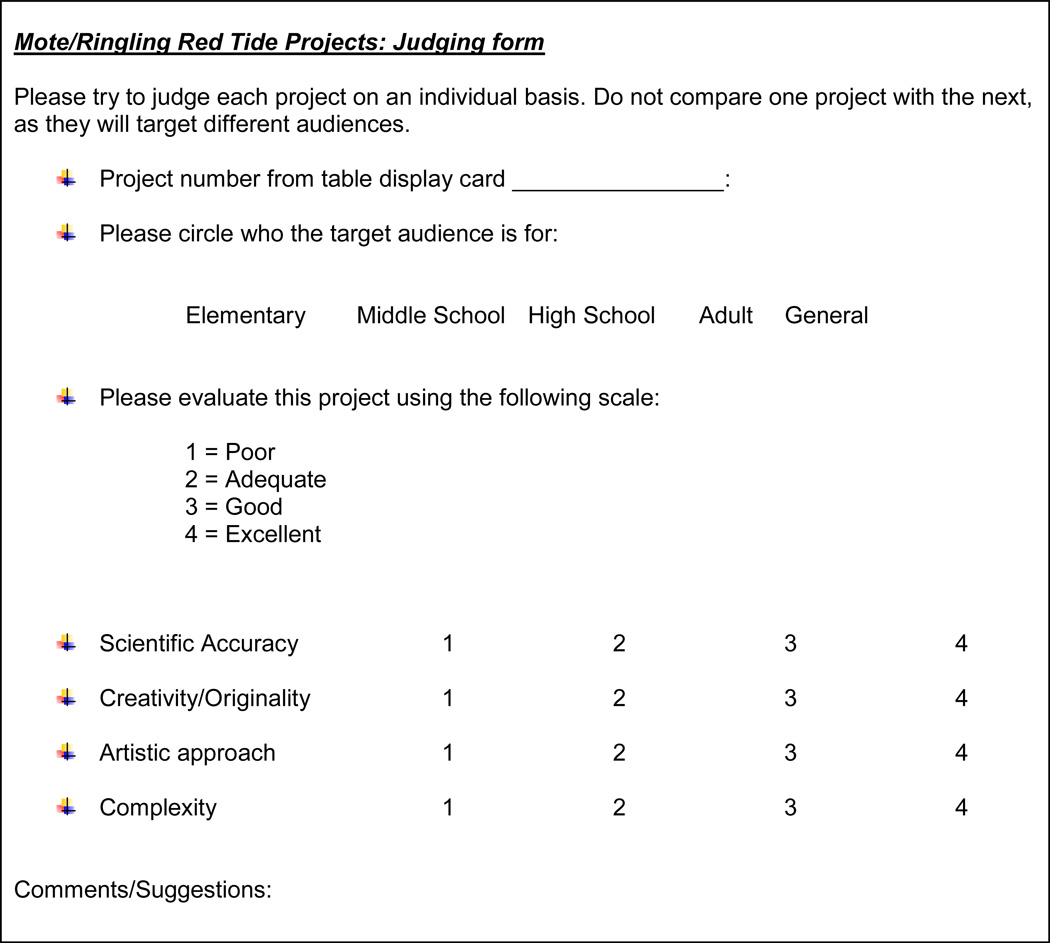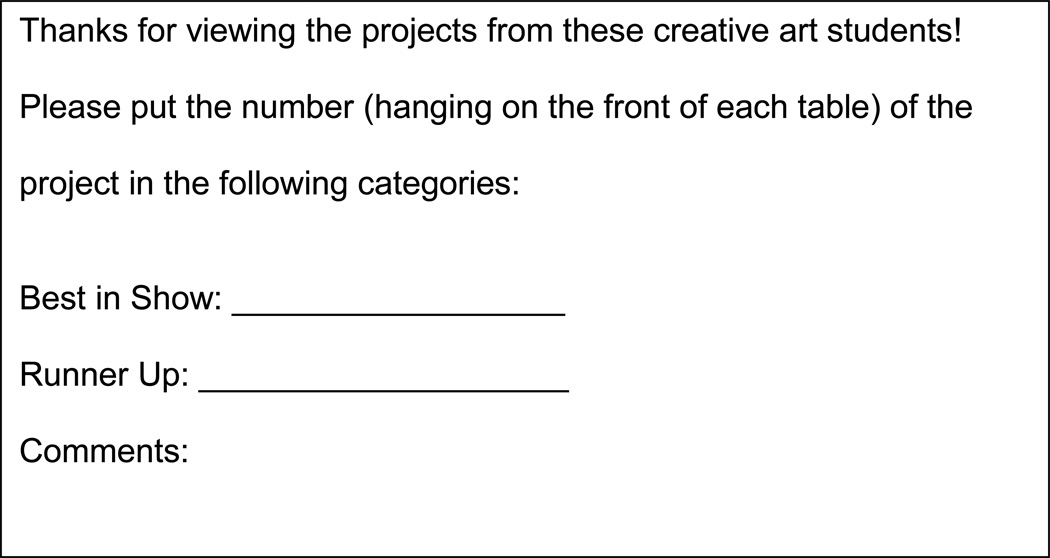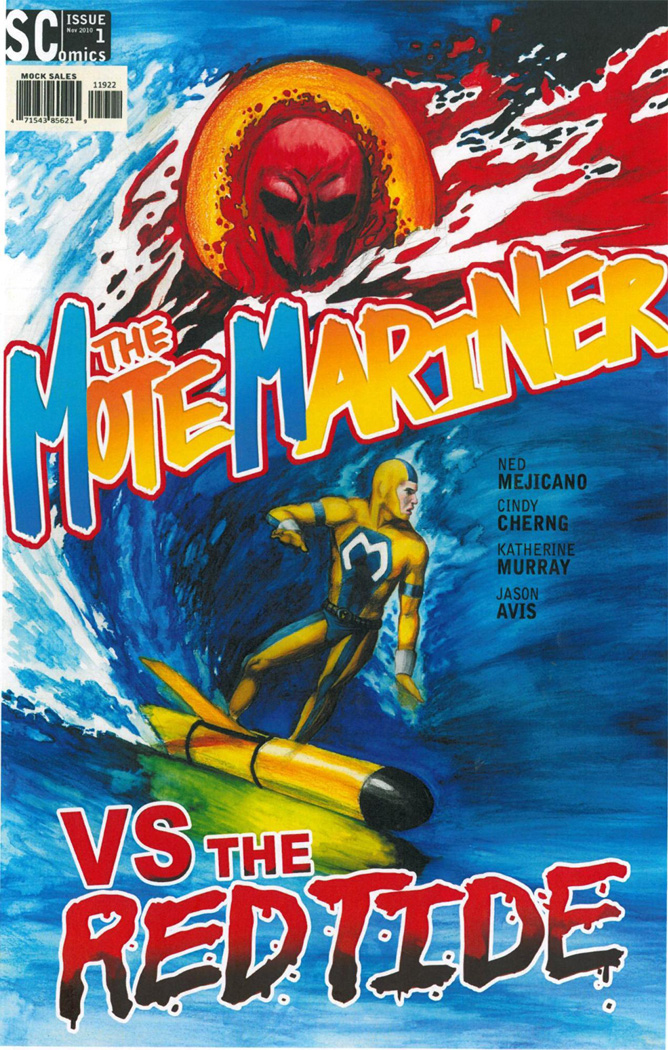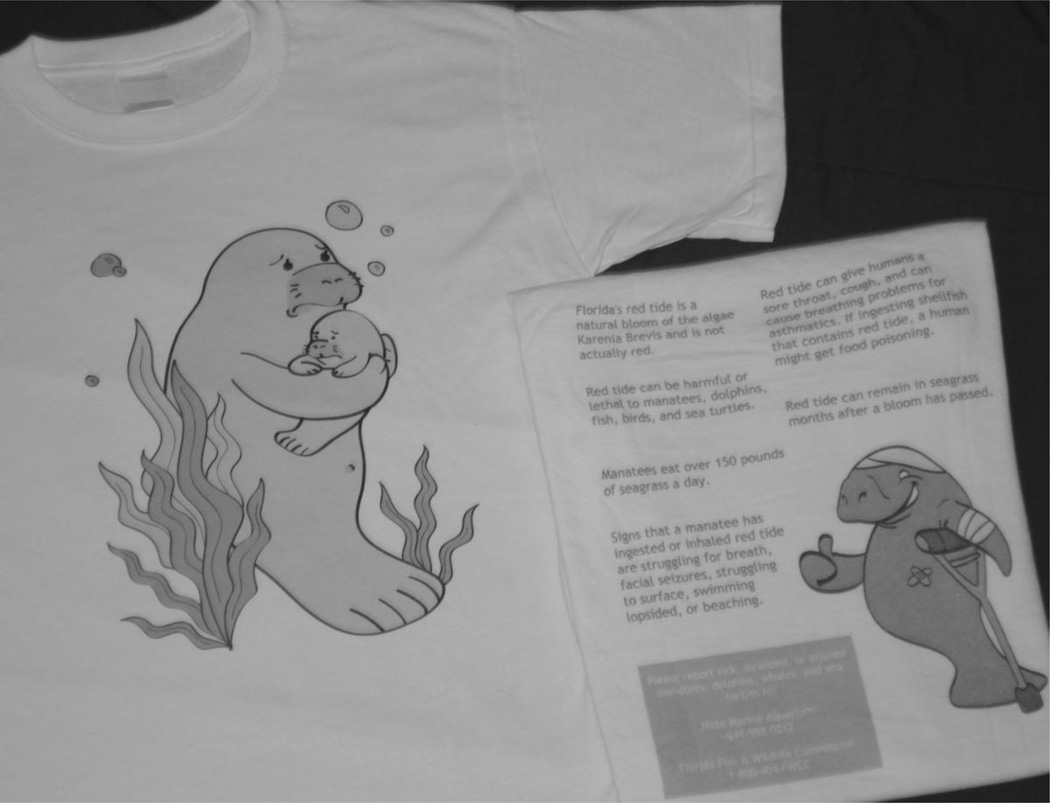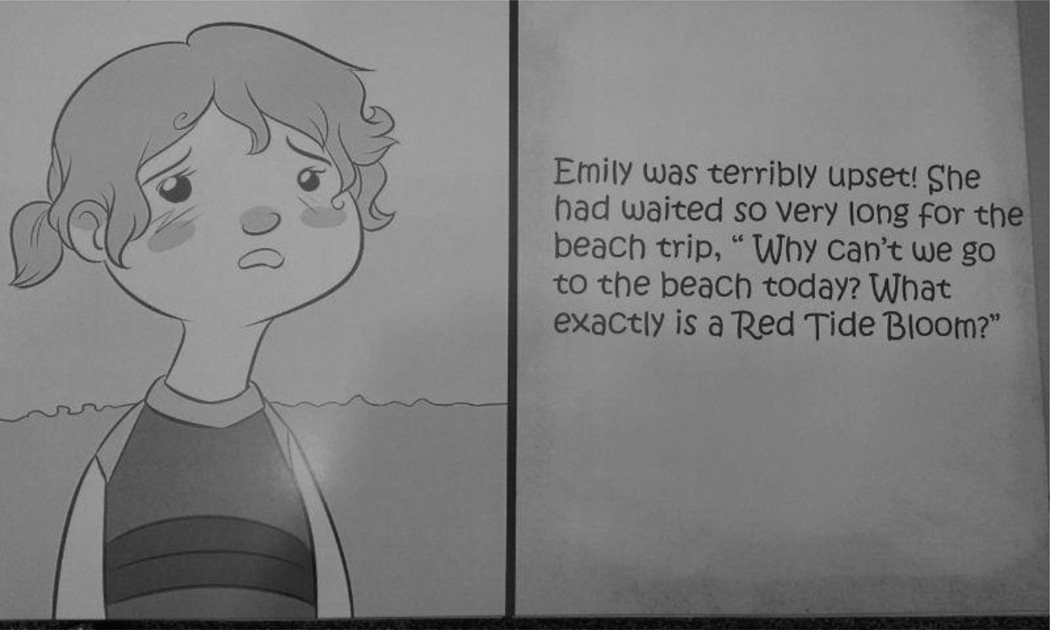Abstract
Over the years, numerous outreach strategies by the science community, such as FAQ cards and website information, have been used to explain blooms of the toxic dinoflagellate, Karenia brevis that occur annually off the west coast of Florida to the impacted communities. Many state and federal agencies have turned to funded research groups for assistance in the development and testing of environmental outreach products. In the case of Florida red tide, the Fish and Wildlife Research Institute/Mote Marine Laboratory (MML) Cooperative Red Tide Agreement allowed MML to initiate a project aimed at developing innovative outreach products about Florida red tide. This project, which we coined “The Art of Red Tide Science,” consisted of a team effort between scientists from MML and students from Ringling College of Art and Design. This successful outreach project focused on Florida red tide can be used as a model to develop similar outreach projects for equally complex ecological issues.
Keywords: Florida red tide, Karenia brevis, communication tools, outreach and education, evaluation of outreach and education, harmful algal blooms and public knowledge, art, community partnerships
1. Introduction
Over the last 20 years, research on the Florida red tide organism and its effects has made significant progress. Unfortunately, both Florida residents and tourists have misconceptions about even the basics of Florida red tide (Kuhar et al., 2009; Nierenberg et al., 2010). We initiated a movement called “The Art of Red Tide Science” to try to address these challenges by combining the artistic talent of the Ringling College of Art and Design (Sarasota, FL) students with the Florida red tide research team at Mote Marine Laboratory (MML) also in Sarasota, FL. This is a unique collaboration in part because Mote Marine Laboratory is co-located with Mote Marine Aquarium, an aquarium opened to the public 365 days a year with a visitorship of nearly 400,000/year. Mote Marine Aquarium exhibits specifically reflect the research projects conducted at MML and thus make a collaborative project such as this easily viewable to visitors to the Aquarium.
Florida red tide (Karenia brevis) is an almost annually occurring dinoflagellate bloom that produces harmful toxins. The airborne release of the toxins can cause human illness as well as have harmful effects on the environment (Kirkpatrick et al., 2004; Fleming et al. 2005; Fleming et al. 2010; Nierenberg et al., 2011). The ecology of Florida red tide is complex and not completely understood (Vargo 2009). Many efforts have been made to study, monitor, and understand the complexities of these blooms including interdisciplinary, multi-year research projects and monitoring programs (Vargo et al. 2008; Pierce et al., 2011), technological advances (Kirkpatrick and Walsh, 2008), and outreach tools (Nierenberg et al., 2011).
Some impacts from Florida red tide that are understood include its effects on local fauna. Karenia brevis blooms can kill fish in vast numbers and has been shown to kill other marine animals including sea turtles, manatees, dolphin, and seabirds (Landsberg et al., 2009). There have also been several documented cases where K. brevis blooms have killed invertebrates (Roberts et al., 1979; Landsberg, 2002). For example, in Tampa Bay, Florida, at least 17 invertebrate species normally present were killed from a red tide bloom (Landsberg, 2002).
Research has also shown that there may be benefits of Florida red tides. For example, brevenal, one of the compounds that is naturally produced by K. brevis, has been shown to act as a blocker to the more toxic compounds that K. brevis produces (Bordelais, et al., 2004). This compound is currently being evaluated as a possible treatment for cystic fibrosis, a debilitating lung disorder (Potera, 2007).
Economic and social science studies on the public perception of Florida red tide effects have consistently revealed widespread misconceptions. The public is generally unclear on what is and what is not safe to do during Florida red tide, such as swimming in a bloom, consumption of organisms from the Gulf of Mexico, or whether there have been any deaths directly attributed to these harmful algal blooms (Kuhar et al., 2009; Nierenberg et al., 2010; Larkin et al., 2011). General knowledge questions about what causes Florida red tide to bloom, what Florida red tide affects, and when blooms occur are also a source of confusion for most residents and tourists of Florida (Nierenberg et al., 2010).
Present efforts for outreach include FAQ cards, wallet-size information cards, websites, social media outlets, and student and teacher workbooks. These are all informative sources of information; however an evaluation of the utilization of all of these tools has not been thoroughly conducted. Measuring and comparing the success of each of these outreach efforts is challenging. For example, FAQ cards that may still be sitting on a hotel shelf somewhere cannot be compared easily with website hits or number of active users on a Facebook page (Nierenberg et al 2011). Furthermore, tracking dissemination of information through either numbers of cards distributed or website hits is not a measure of the understanding of that material by the user.
The future of outreach tools is rapidly changing. Groffman et al. (2010) found that scientists need to become more active in communicating information, and to do that they must engage audiences in new ways. One way is to involve people outside of the science realm, who have skill sets, or who have been trained in areas in which scientists aren’t typically trained. Artists, for example, are very creative and often present ideas that suggest alternate ways of visualizing. This can be important considering that the target audience for many public outreach topics may not always absorb written information, whereas a visual image of an environmental issue may be easier to comprehend. Additionally, scientists and policy makers now consider online resources like Facebook and YouTube not only popular places for the public to get information, but also as a catalyst for collaboration and innovation (Nisbet et al., 2010; Pace et al., 2010).
Our goal in initiating “The Art of Red Tide Science” was to create an innovative outreach program on Florida red tide. After presenting our approach/methods, we discuss ways of evaluating the program’s success as well as lessons learned.
2. Methods
In collaboration with college leadership, this project was incorporated into coursework for Ringling College of Art and Design students as part of the science curriculum, in four parts: a proposal, a paper, a project, and a final presentation of work. Students formed groups of three to four people (assigning one person from each group as team leader/spokesperson) and chose from a list of different topics on Florida red tide to address. Topics included: control and prevention, economic/real estate/tourism issues, nutrients, monitoring, mitigation (how to “get rid of” red tide and should you), history/culture, human health, and technology. Class time was used for basic information sharing, regarding Florida red tide and for the development of specific projects. After researching one of the topic areas, the student groups were required to conduct at least one interview with a Florida red tide expert (a list of potential interviewees was provided) on their specific topic as a “fact checker” to minimize misinterpretations with other species of red tides. Students were expected to create a list of questions prior to the interview. The interview was required to be recorded and a synopsis of the interview was part of the grading criteria for the assignment. To encourage students to gain knowledge from other scientists, the course professors were not available for interviews, but acted as advisors to the students throughout the duration of the project.
Groups were given the option to create their project in any medium of their choice, such as: videos, posters, books, clothing lines, video games, and smart phone applications (Table 1). Each group was given a maximum budget of $200.00 for project supplies. One person in each group was in charge of the budget and was required to turn in a written request for funds, as well as provide receipts at the end of the project to emulate actual proposal and project development and completion.
Table 1.
Types of project mediums and appropriate age groupings
| Targeted Age Group | |||
|---|---|---|---|
| K – 12 | Adult | General | |
| Web (blogs etc) | 3 | ||
| Video | 2 | 4 | |
| Video Game | 1 | ||
| Book | 2 | 1 | 1 |
| Clothing Line | 3 | ||
| Poster | 1 | 1 | |
| Pamphlet | 2 | ||
| Smart Phone App | 2 | ||
| Physical Object | 3 | 2 | |
| TOTAL | 9 | 15 | 4 |
The final projects were presented as a one-night event at Mote Marine Aquarium in an art gallery/science fair format. During that time, projects were judged by invited MML staff, Fish and Wildlife Research Institute staff, Ringling College staff, and other members of the Florida red tide community. Each student group was available for interviews during this event. Judging criteria was based on scientific accuracy, creativity/originality, artistic approach, and complexity (Figure 1). Projects were placed on display for one week as a temporary exhibit at Mote Marine Aquarium and made viewable to the aquarium visitors. These visitors were also given the opportunity to vote and comment using a general voting form (Figure 2).
Figure 1.
Judge form for the MML/Ringling College of Art and Design Florida red tide outreach project.
Figure 2.
Public voting form for the MML/Ringling College of Art and Design Florida red tide outreach project.
Awards were given to the winning group as determined by the judges and to the winning group as determined from the aquarium visitors voting consensus. The winning projects were displayed as the main object of the Facebook page (http://www.facebook.com/pages/The-Art-of-Red-Tide-Science/191835257510999) and the winning group was also announced via press release. Thusfar, projects have been completed and presented for two semesters (Fall 2010 and Spring 2011, Figures 3 through 5).
Figure 3.
The winning group from the fall 2010 semester “The Mote Mariner vs. the Red Tide” as voted on by a panel of judges as well as by Mote Marine Aquarium guests.
Figure 5.
An example of one of the top-ranking projects, a t-shirt about the effects of Florida red tide on manatees.
3. Evaluation
Accurate records for number of judges and number of viewers to the exhibits were maintained by MML staff and volunteers (Table 2). The number of visitors to the exhibit was much greater during the spring semester for two reasons: the location of the exhibit within Mote Marine Aquarium was more accessible and presentable to aquarium guests during the second semester; and the time of year (Easter week) of the exhibit was a more popular time for guests to visit Mote Marine Aquarium than the first semester (the week following Thanksgiving weekend).
Table 2.
Number of viewers and judges at each of the project events
| Fall 2010 | Spring 2011 | |
|---|---|---|
| Number of Judges | 8 | 9 |
| Number of Visitors | +200 | +2000 |
A Facebook page was formed (http://www.facebook.com/pages/The-Art-of-Red-Tide-Science/191835257510999), which acts as a resource to view previous projects and to guide interested mentors and students. Data is generated through the Facebook website allowing MML staff to assess usage.
Judging records and aquarium visitor ballots were collated. Results for the first semester exhibit (fall 2010) were the same for both the judges and the Mote Marine Aquarium visitors votes (Figure 3). Results from the second semester exhibit (spring 2011) produced two different winners. During this exhibit, the panel of judges chose an information video while the aquarium visitors chose a video game.
4. Discussion
It has been shown that efforts for public communication concerning complex ecological topics need to be interdisciplinary, including scientists, communication experts, and media professionals (Maibach et al, 2008; Nisbet and Scheufele, 2009; Groffman et al., 2010). This has been attempted with previous outreach projects concerning distribution of Florida red tide information to the public; however, surveys of both tourists and Gulf coast residents have shown that traditional methods have not always been successful in getting the correct message across (Nierenberg et al., 2011). This project came from an innovative initiative to utilize the skills of art students at a premier art college to produce outreach products for a complex topic that has been historically difficult to communicate to the general public. Evaluations from the general public as well as local scientists, managers, and other experts involved with Florida red tide research who judged this project found it successful in drawing people in, presenting nearly accurate information, and providing overall entertainment value.
One of the main lessons learned from this project is that art students are far more creative than scientists when producing outreach materials. Though it was evident that the students did not have the initial background in Florida red tide research, they were able to take the information presented to them, synthesize it, and present it in a manner that captivated aquarium visitors. It is often assumed that most people learn about science through school, when in fact, most learning has been shown to be through the media, museums, and interpersonal contacts (Falk and Dierking, 2000; NRC, 2009; Goffman et al., 2010). It is in those teachable moments that people are learning something they have an interest in, instead of learning something because they are required to do so. The creativity expelled by art students adds uniqueness, or perhaps feeling, to outreach tools that is lacking in tools created by scientists. The artists are able to engage with the science and create images that suggest alternate ways of seeing (Ede, 2005).
There were some challenges throughout the duration of this outreach project. One of the main challenges was that most of the students did not have a science background; with the exception of a few local students, almost none had heard of Florida red tide. Even those who were local residents did not know or understand much more about it than what they had heard through the media. Therefore, a lot of the general information had to come from the professors’ introduction of Florida red tide, or from online sources, which can also provide misleading information depending on the source. Another challenge was that information on Florida red tide in the final projects was generally 80 to 90% accurate, most likely because of the difficulty and complexity of the subject. Therefore the consensus among the judges was that an engaged audience was more important than complete accuracy. The products written by scientists and then made visually interesting by graphic artists are 100% accurate but are too detailed and not “eye catching” (Nierenberg et al 2011), whereas the engaging and effective products created by these artists can easily be corrected before distribution to the public at large.
This project was beneficial both to the Florida red tide scientists and the Ringling College of Art and Design art students. It provided the scientists with creative outreach products that enabled them to share the science of Florida red tide with the general public in a striking and interesting manner. The art students are interested in building their portfolios and can include this work as a published art piece, especially if it’s part of the winning group. Additionally, this project demonstrated a new technique for creating multiple outreach product prototypes in a short period of time, on a limited budget. In one semester, an average of 15 unique products were created. Although not all products were deemed usable, many could be modified easily to become functional products. The typical output between scientists with a dedicated graphic artist may include only one product within the same time period, without the benefit of new mediums for presenting that product (such as a YouTube video or a video game) (Nierenberg et al 2011).
Feedback from community stakeholders was positive. Guests who visited Mote Marine Aquarium during the show left many comments describing how much they learned as well as how creative and eye-catching the projects were. Voting results were the same among the panel of judges and the aquarium guests the first semester, however they were in disagreement the second semester. The winning project as voted on by the aquarium guests was a video game that had very little scientific information content but high entertainment value. One possible explanation for this difference is that on the visitors’ ballot, there is no explicit statement that scientific content is criteria for evaluation (Figure 2).
“The Art of Red Tide Science” outreach project can be used as a model to develop similar outreach projects for different, but similarly complex ecological issues. It was successful in reaching the community, there was positive feedback from judges and aquarium visitors, and it benefitted the students. Although having an art college with collaborative instructors seems to be a limitation for replication, most science faculty have an art department within their own institutions that can be utilized. Also of benefit for distributing finished products would be a marketing or business department, often found within the same institution.
5. Conclusions
The products developed under this project were able to reach people of all ages in the local community, including Florida red tide scientists and resource managers. The products were creative, informative, and unique and have captured the interest of researchers in other disciplines who might use this experiment as a tool for new public outreach product inventions. How the public gets information is changing rapidly and creating methods to make outreach products accurate and interesting will continue to be a challenge. This innovative approach has successfully demonstrated the value of art in communicating science and has reached the broad community where other products have not.
10.0 Highlights.
-
>
We review innovative outreach products for Florida red tide created by a novel collaboration of scientists and art students.
-
>
Changes in outreach methods reach the public where traditional approaches have not.
-
>
Collaboration of artists and scientists to create outreach products is beneficial.
-
>
We create a tool that can be used as a model to develop similar outreach projects for similarly complex ecological issues.
Figure 4.
An example of one of the top-ranking projects, a children’s book about Florida red tide.
Acknowledgements
We thank all of the students at Ringling College of Art and Design who participated in this project. We also thank everyone who participated as judges including MML staff: K. Dixon, G. Kirkpatrick, R. Pierce, N. Slimak, M. Wells, H. Rutger, and A. Nissanka; FWRI staff: K. Steidinger, L. Flewelling, M. Garrett, and W. Quigley; Ringling College of Art and Design staff: T. Rummage and D. Chismar; Sarasota County: J. Grimes; START: S. Gilbert; and visitors to Mote Marine Aquarium who took the time to view and vote during the project showing. Funding was provided by Mote/FWC-FWRI Cooperative Red Tide Research Program (FWC Agreement No. 07041), NIEHS R21ES017413-01A2, and NSF GEO-1009063.
Footnotes
Publisher's Disclaimer: This is a PDF file of an unedited manuscript that has been accepted for publication. As a service to our customers we are providing this early version of the manuscript. The manuscript will undergo copyediting, typesetting, and review of the resulting proof before it is published in its final citable form. Please note that during the production process errors may be discovered which could affect the content, and all legal disclaimers that apply to the journal pertain.
References
- Bourdelais AJ, Campbell S, Jacocks H, Naar J, Wright JL, Carsi J, Baden DG. Brevenal is a natural inhibitor of brevetoxin action in sodium channel receptor binding assays. Cell. Mol. Neurobiol. 2004;24(4):553–563. doi: 10.1023/B:CEMN.0000023629.81595.09. [DOI] [PMC free article] [PubMed] [Google Scholar]
- Ede S. Art and science. London: I.B. Taurus and Co. Ltd.; 2005. [Google Scholar]
- Falk JH, Dierking LD. Learning from museums: visitor experiences and the making of meaning. Walnut Creek, CA: AltaMira Press; 2000. [Google Scholar]
- Fleming LE, Kirkpatrick B, Backer LC, Walsh CJ, Nierenberg K, Clark J, Reich A, Hollenbeck J, Benson J, Cheng YS, Naar J, Pierce R, Bourdelais AJ, Abraham WM, Kirkpatrick G, Zaias J, Wanner A, Mendes E, Shalat S, Hoagland P, Stephan W, Bean J, Watkins S, Clarke T, Byrne M, Baden DG. Review of Florida red tide and human health effects. Harmful Algae. 2010;10:224–233. doi: 10.1016/j.hal.2010.08.006. [DOI] [PMC free article] [PubMed] [Google Scholar]
- Fleming LE, Kirkpatrick B, Backer LC, Bean JA, Wanner A, Dalpra D, Tamer R, Zaias J, Cheng YS, Pierce R, Naar J, Abraham W, Clark R, Zhou Y, Henry MS, Johnson D, Van de Bogart G, Bossart GD, Harrington M, Baden DG. Initial evaluation of the effects of aerosolized Florida red tide toxins (brevetoxins) in persons with asthma. Environ. Health Persp. 2005;113(5):650–657. doi: 10.1289/ehp.7500. [DOI] [PMC free article] [PubMed] [Google Scholar]
- Groffman PM, Sylinski C, Nisbet MC, Duarte CM, Jordan R, Burgin A, Previtali AM, Coloso J. Restarting the conversation: challenges at the interface between ecology and society. Front. Ecol. Environ. 2010;8(6):284–291. [Google Scholar]
- Kirkpatrick B, Fleming LE, Squicciarini D, Backer LC, Clark R, Abraham W, Benson J, Cheng YS, Johnson D, Pierce R. Literature review of Florida red tide: implications for human health effects. Harmful Algae. 2004;3:99–115. doi: 10.1016/j.hal.2003.08.005. [DOI] [PMC free article] [PubMed] [Google Scholar]
- Kirkpatrick GJ, Walsh JJ. Ecology and oceanography of harmful algal blooms in Florida (special Issue) 2008;28(1):1–214. [Google Scholar]
- Kuhar S, Nierenberg K, Kirkpatrick B, Tobin GA. Public perceptions of Florida red tide risks. Risk Anal. 2009;29(7):963–969. doi: 10.1111/j.1539-6924.2009.01228.x. [DOI] [PMC free article] [PubMed] [Google Scholar]
- Landsberg JH, Flewelling LJ, Naar J. Karenia brevis red tides, brevetoxins in the food web, impacts on natural resources: decadal advancements. Harmful Algae. 2009;8:598–607. [Google Scholar]
- Landsberg JH. The effects of harmful algal blooms on aquatic organisms. Rev. Fish. Sci. 2002;10:113–390. [Google Scholar]
- Larkin S, Lucas KM, Adams CM, Stevely J. Electronic Data Information Source (EDIS) FE891. Gainesville, FL: University of Florida; 2011. Strategies to address red tide events in Florida: results of a 2010 survey of coastal residents. http://edis.ifas.ufl.edu/FE891. [Google Scholar]
- Maibach EW, Roser-Renouf C, Leiserowitz A. Communication and marketing as climate change intervention assets: a public health perspective. Am. J. Prev. Med. 2008;35:488–500. doi: 10.1016/j.amepre.2008.08.016. [DOI] [PubMed] [Google Scholar]
- Nierenberg K, Hollenbeck J, Fleming LE, Stephan W, Reich A, Backer LC, Currier R, Kirkpatrick B. Frontiers in outreach and education: The Florida red tide experience. Harmful Algae. 2011;10:374–380. doi: 10.1016/j.hal.2011.01.004. [DOI] [PMC free article] [PubMed] [Google Scholar]
- Nierenberg K, Byrne MM, Fleming LE, Stephan W, Reich A, Backer LC, Tanga E, Dalpra D, Kirkpatrick B. Florida red tide perception: residents versus tourists. Harmful Algae. 2010;9(6):600–606. doi: 10.1016/j.hal.2010.04.010. [DOI] [PMC free article] [PubMed] [Google Scholar]
- Nisbet MC, Scheufele DA. What’s next for science communication? Promising directions and lingering distractions. Am. J. Bot. 2009;96:1–12. doi: 10.3732/ajb.0900041. [DOI] [PubMed] [Google Scholar]
- Nisbet MC, Hixon MA, Moore KD, Nelson M. Four cultures: new synergies for engaging society on climate change. Front. Ecol. Environ. 2010;8:329–331. [Google Scholar]
- NRC (National Research Council) Learning science in informal environments: people, places, and pursuits. Washington, DC: The National Academies; 2009. [Google Scholar]
- Pace ML, Hampton SE, Limburg KE, Bennett EM, Cook EM, Davis AE, Grove JM, Kaneshiro KY, LaDeau SL, Likens GE, McKnight DM, Richardson DC, Strayer DL. Communicating with the public: opportunities and rewards for individual ecologists. Front. Ecol. Environ. 2010;8:292–298. [Google Scholar]
- Pierce RH, Bartels E, Boyes A, Dixon K, Hall E, Henry M, Kirkpatrick B, Kirkpatrick G, Lovko V. Mote/FWC-FWRI cooperative red tide research program: monitoring, prediction, and mitigation of Florida red tides. Annual Report to FWC, FWC Agreement No. 07041, Mote Technical Report 1547. 2011 [Google Scholar]
- Potera C. Florida red tide brews up drug lead for cystic fibrosis. Science. 2007;316(5831):1561–1562. doi: 10.1126/science.316.5831.1561. [DOI] [PMC free article] [PubMed] [Google Scholar]
- Roberts BSA, Henderson GE, Medlyn RA. The effect of Gymnodinium breve toxin(s) on selected mollusks and crustaceans. In: Taylor DL, Seliger HH, editors. Toxic dinoflagellate blooms. North Holland: Elsevier; 1979. pp. 419–424. [Google Scholar]
- Vargo G. A brief summary of the physiology and ecology of Karenia brevis Davis (G. Hansen and Moestrup comb. nov.) red tides on the West Florida Shelf and of hypotheses posed for their initiation, growth, maintenance, and termination. Harmful Algae. 2009;8(4):573–584. [Google Scholar]
- Vargo GA, Heil CA, Fanning KA, Dixon LK, Neely MB, Lester K, Ault D, Murasko S, Havens J, Walsh J, Bell S. Nutrient availability in support of Karenia brevis blooms on the central West Florida Shelf: what keeps Karenia blooming. Cont. Shelf Res. 2008;28(1):73–98. [Google Scholar]



